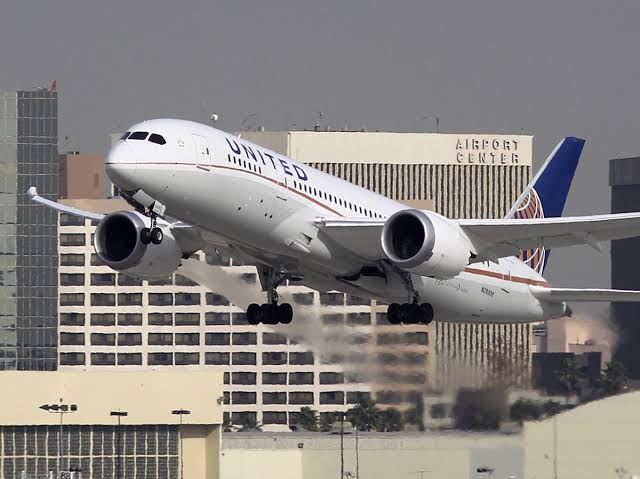
United Airlines Boeing 757-200 lost a landing-gear wheel during takeoff from Los Angeles International Airport. Despite the alarming situation, the aircraft continued its flight and landed safely at Denver International Airport, sparking a broader discussion about the safety of aging aircraft and the stringent maintenance protocols that airlines must follow.*
In a rare and concerning event, United Airlines Flight 1001, a Boeing 757-200, experienced a malfunction shortly after taking off from Los Angeles International Airport (LAX) on Monday. As the aircraft ascended into the skies, one of its landing gear wheels detached from the plane, leaving passengers and crew unaware of the potential danger that lay ahead.
The flight, bound for Denver International Airport (DEN), carried on without incident, despite the loss of a crucial component. The wheel, which plummeted back to the ground, was later recovered at LAX. Passengers on board were reportedly oblivious to the mishap as the flight crew, following standard procedures, ensured that the aircraft remained stable throughout the journey.
United Airlines confirmed the incident later that day, emphasizing that the safety of their passengers and crew is always their top priority. “We are investigating what caused this event,” the airline stated in a brief release. The airline’s quick response and the successful landing in Denver highlight the effectiveness of modern aircraft safety systems and the professionalism of the crew in managing in-flight emergencies.
The aircraft involved in this incident was a nearly 30-year-old Boeing 757-200, a model that Boeing ceased producing in 2004. The longevity of such planes has become a topic of interest within the aviation industry, where the balance between extending the service life of older aircraft and ensuring the highest safety standards is continually evaluated.
Boeing’s 757 series has been a workhorse in the airline industry since its introduction in the early 1980s, with many airlines continuing to operate these aircraft due to their reliability and range capabilities. However, as these planes age, they require more intensive maintenance and inspections to remain airworthy.
In this case, the loss of a landing-gear wheel during takeoff raises questions about the maintenance and inspection protocols for aging aircraft. While it’s not uncommon for older planes to remain in service, the incident underscores the importance of rigorous maintenance schedules and frequent checks on critical components.
United Airlines, like all major carriers, adheres to strict maintenance protocols as mandated by the Federal Aviation Administration (FAA). These protocols include regular inspections, repairs, and part replacements to ensure that aircraft meet all safety standards. However, incidents like this one bring to light the potential risks associated with older aircraft.
The FAA requires that aircraft undergo various levels of checks, ranging from daily inspections to more comprehensive examinations that occur every few years. For aging aircraft, these checks become even more crucial, as wear and tear over decades of service can lead to unexpected failures.
The wheel loss incident will likely prompt a thorough investigation by both United Airlines and the FAA. Such investigations typically involve a detailed examination of the aircraft’s maintenance records, the condition of the landing gear, and any previous issues reported with the plane. The goal is to determine whether the incident was due to a maintenance oversight, a manufacturing defect, or simply the result of the aircraft’s age.
This is not the first time United Airlines has faced such an issue. In March of this year, another United flight, a Boeing 777-200, lost a tire mid-air shortly after taking off from San Francisco International Airport (SFO). The aircraft, en route to Japan, was forced to divert and make an emergency landing at Los Angeles International Airport. Fortunately, the flight landed without further complications, and no injuries were reported.
These incidents, though rare, highlight the challenges airlines face in maintaining their fleets, especially as some aircraft models approach the end of their operational life spans. While modern planes are designed with multiple redundancies to handle such emergencies, the aviation industry must remain vigilant to prevent similar occurrences.
While United Airlines has successfully managed these incidents, ensuring the safety of passengers and crew, such events can still affect public confidence. Passengers may become wary of flying on older aircraft, even though statistically, air travel remains one of the safest modes of transportation.
To address these concerns, United Airlines has reiterated its commitment to safety and the rigorous maintenance of its fleet. The airline is also cooperating fully with the FAA’s investigation, which will likely result in recommendations or actions to prevent future incidents.
The safe landing of United Airlines Flight 1001 in Denver is a testament to the skill of the flight crew and the robust design of the Boeing 757-200. However, it also serves as a reminder of the ongoing challenges airlines face in maintaining older aircraft. As the investigation unfolds, it will provide valuable insights that could influence future aviation safety standards and maintenance practices.